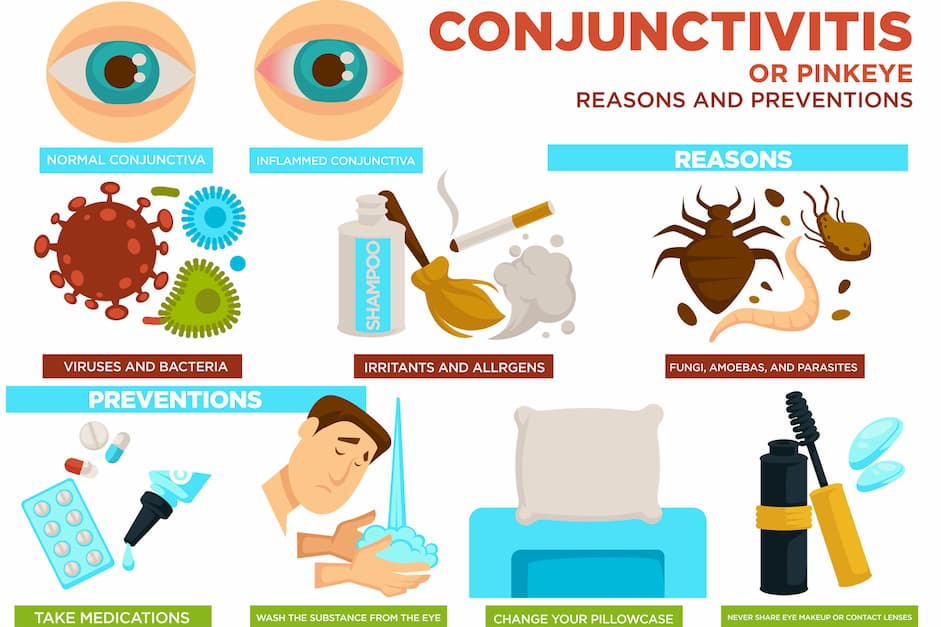Viral conjunctivitis is a condition in the eyes that causes inflammation in an area called the conjunctiva. The conjunctiva is the layer of tissue that covers the white of the eye and also the eyelid. This type of condition is also called “acute conjunctivitis” or sometimes “red-eye” because of the symptoms it causes, which we will learn more about later. This conjunctivitis is characterized by being caused by a virus, but you should know that this condition can also be caused by bacteria. However, 80% of cases of acute conjunctivitis are caused by viruses. It can be caused by different viruses, many of which are associated with upper respiratory infections, colds, or sore throats. The majority of the cases of viral conjunctivitis are caused by adenovirus. Other viruses that can cause it are enterovirus and Coxsackievirus.
Symptoms of Viral Conjunctivitis

The causes of each particular case of conjunctivitis are challenging to analyze since all types of viruses have very similar symptoms; these can include:
- Inflammation of the layer of tissue that covers the white part of the eye and the inside of the eyelid (named conjunctiva) or the eyelids.
- Lacrimation increased.
- Sometimes scabs form on the eyelids or eyelashes, especially in the morning.
- Pain or enlargement of the lymph nodes in front of the ears. With a touch, the swelling may feel like a small lump. (Lymph nodes are like filters in the body, picking up and destroying viruses and bacteria.)
- Itching, irritation, or burning.
- Mild fever (no higher than 38ºC)
- Possible symptoms of a cold, flu, or other respiratory infection.
- It can sometimes cause photophobia.
- A watery, white, or yellowish discharge (more common in bacterial conjunctivitis).
- Pink or red color to the white of the eye (usually both eyes when it is viral).
- The feeling of having a foreign object (like sand) inside the eye or wanting to rub the eye.
Transmission
Viral conjunctivitis is very easy to spread, and it can quickly make several people sick in a short time. It spreads through direct contact with fingers, medical instruments, swimming pool water, or personal hygiene items.
When To Seek Medical Attention

You should see a doctor if:
- Conjunctivitis develops in immunosuppressed patients (someone who has a weakened immune system) from cancer treatment, HIV infection, or other medical treatments or conditions.
- If bacterial conjunctivitis is being treated with antibiotics and does not improve within 24 hours of starting treatment.
- Conjunctivitis causes severe redness in the eyes.
- The symptoms of conjunctivitis worsen or continue, and it is suspected that the patient may have a severe form of conjunctivitis, for example, caused by the herpes simplex or varicella-zoster viruses (the cause of chickenpox and shingles).
- If you are suffering from eye pain, moderate to severe.
- If problems with vision occur, such as sensitivity to light or blurred vision, which does not improve when all the mucosa is removed from the eyes.
How is it Diagnosed?

The diagnosis is based on the symptoms and history of the patient. For example, if conjunctivitis occurs with a common cold or respiratory tract infection, and if the discharge from the eye is liquid and not thick, the cause is probably a virus. The information provided by the patient is also very important, such as having been in contact with someone who has conjunctivitis, having had an eye exam, among other things. All information helps the doctor to determine the condition. Laboratory tests are usually not necessary to diagnose viral conjunctivitis. However, tests may be carried out if a more severe form of conjunctivitis is suspected, such as conjunctivitis caused by the varicella-zoster virus or the herpes simplex virus. These tests are done by analyzing a sample of the discharge from the infected eye.
Treatment

Almost all cases that present develop light symptoms and the disease usually disappears without treatment between 7 and 14 days after acquiring the virus. Besides, it does not present long-term consequences. The worst time of infection is between the third and fifth day, and in some cases, it can take up to three weeks to clear up, especially if complications arise. Most cases of viral conjunctivitis are mild.
Some tips that can help you better withstand the infection:
- Apply a drop of artificial tears to the affected eye several times a day to relieve dryness and inflammation. Artificial tears are sold without a prescription in pharmacies.
- Put cold compresses on your eyes for a few minutes to cool them down.
- Clean your eyes at least three times a day using warm, previously boiled water and a clean cotton ball or sterile gauze (one piece for each eye). Wipe in one direction only (either toward the nose or the other way, whichever is easiest for you). Get rid of the cotton ball each time to avoid recontamination. DO NOT try to clean inside the eyelids as this can cause damage to the conjunctiva.
- Try to avoid the use of steroid anti-inflammatory drugs (dexamethasone and other similar drugs) since they can increase the replication of the virus and the duration of the disease.
Remember that antibiotics are not indicated for conjunctivitis, as they are not effective against viruses. Taking antibiotics can complicate the disease by producing allergies and other side effects that make a medical diagnosis of other possible eye diseases difficult.
Bottom Line
This type of conjunctivitis is an eye condition that can be caused by different types of viruses. It spreads easily; however, it usually heals without treatment in one to two weeks. If you think you might have conjunctivitis, you should go to the doctor to get a proper assessment, do not risk your health.

